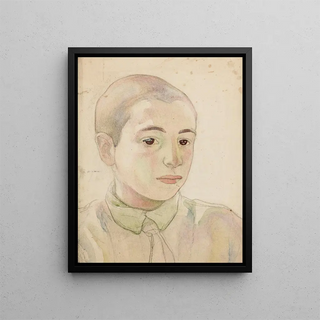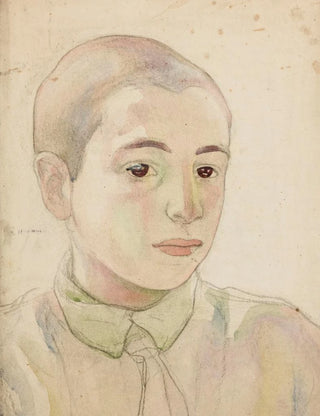Art print | The boy's head is unfinished - Nikolai Triik


View from behind

Frame (optional)
La tête du garçon est inachevée - Nikolai Triik is a captivating artwork that fascinates with its simultaneously unfinished and deeply evocative character. This painting, which appears suspended between the world of completion and that of the sketch, invites us to delve into the inner universe of its subject. The depiction of a young boy, whose face barely emerges from the canvas, evokes a certain nostalgia and prompts reflection on the very nature of art. This deliberate choice to leave some elements unfinished stimulates the viewer's imagination, inviting them to complete the work with their own thoughts and emotions. Thus, this piece is not merely a portrait; it becomes a dialogue between the artist, the subject, and the audience.
Style and uniqueness of the work
Nikolai Triik's style is distinguished by a subtle and introspective approach. The brushstrokes, both delicate and assertive, demonstrate technical mastery that transcends simple representation. In La tête du garçon est inachevée, the artist plays with light and shadow to create an atmosphere that is both mysterious and captivating. The chosen tones, soft and nuanced, reinforce the idea of inherent fragility in childhood. The composition, although partially incomplete, exudes harmony that draws the eye and invites contemplation. Triik manages to capture an essence, an emotion, without relying on detailed precision, which makes his work all the more poignant and timeless.
The artist and his influence
Nikolai Triik, an emblematic figure of Estonian art, has established himself through his innovative approach and unique sensitivity. Born at a time when art was undergoing profound upheavals, he managed to incorporate various influences while maintaining a distinct identity. His work is part of a movement that values personal expression and emotional exploration. Triik was also influenced by his contemporaries, notably symbolist and impressionist currents, which enriched his artistic language. Through his creations, he paved the way for new reflections on the role of art in society.

Matte finish

View from behind

Frame (optional)
La tête du garçon est inachevée - Nikolai Triik is a captivating artwork that fascinates with its simultaneously unfinished and deeply evocative character. This painting, which appears suspended between the world of completion and that of the sketch, invites us to delve into the inner universe of its subject. The depiction of a young boy, whose face barely emerges from the canvas, evokes a certain nostalgia and prompts reflection on the very nature of art. This deliberate choice to leave some elements unfinished stimulates the viewer's imagination, inviting them to complete the work with their own thoughts and emotions. Thus, this piece is not merely a portrait; it becomes a dialogue between the artist, the subject, and the audience.
Style and uniqueness of the work
Nikolai Triik's style is distinguished by a subtle and introspective approach. The brushstrokes, both delicate and assertive, demonstrate technical mastery that transcends simple representation. In La tête du garçon est inachevée, the artist plays with light and shadow to create an atmosphere that is both mysterious and captivating. The chosen tones, soft and nuanced, reinforce the idea of inherent fragility in childhood. The composition, although partially incomplete, exudes harmony that draws the eye and invites contemplation. Triik manages to capture an essence, an emotion, without relying on detailed precision, which makes his work all the more poignant and timeless.
The artist and his influence
Nikolai Triik, an emblematic figure of Estonian art, has established himself through his innovative approach and unique sensitivity. Born at a time when art was undergoing profound upheavals, he managed to incorporate various influences while maintaining a distinct identity. His work is part of a movement that values personal expression and emotional exploration. Triik was also influenced by his contemporaries, notably symbolist and impressionist currents, which enriched his artistic language. Through his creations, he paved the way for new reflections on the role of art in society.






